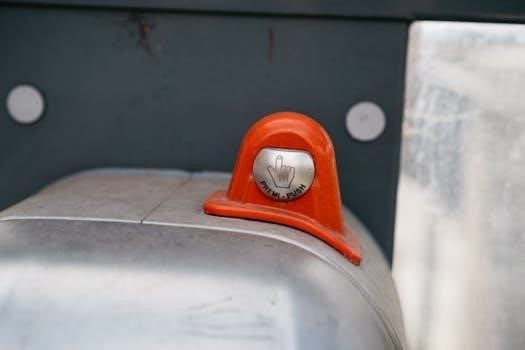Here’s the text for the “Rival Ice Cream Machine Instructions⁚ A Comprehensive Guide” section⁚

Rival Ice Cream Machine Instructions⁚ A Comprehensive Guide
Making homemade ice cream with a Rival machine can be a delightful experience. This guide provides a roadmap to understanding your machine. It covers everything from finding manuals to essential maintenance tips for optimal performance, ensuring delicious frozen treats every time.
Finding the Right Manual
Locating the correct manual for your Rival ice cream maker is the first step toward successful ice cream creation. The manual contains crucial information about your specific model, including operating instructions, safety guidelines, and troubleshooting tips. Start by checking the original packaging if you still have it. The manual is often included with the product literature.
If you can’t find the physical manual, the internet is your friend. Search online using the model number of your Rival ice cream maker. Many websites offer downloadable manuals in PDF format. Be sure to download the manual from a reputable source to avoid malware or incorrect information. You can also try searching for the manual on the Rival website, if available, or on online forums and communities dedicated to ice cream makers. Remember to specify the model number.
If you are unable to find the exact manual, a manual for a similar Rival model may offer helpful information, as the Rival 5 Quart Wood Bucket Ice Cream Maker Model⁚ 8550-X sure looks like the Richmond Cedar Works model.
Identifying Your Model Number
Before you can effectively troubleshoot issues, find replacement parts, or even download the correct manual, you need to identify your Rival ice cream maker’s model number. This unique identifier is crucial for accessing specific information related to your machine. The model number is typically a combination of numbers and sometimes letters, and it’s usually found on a sticker or plate attached to the appliance.
Look for the model number on the bottom of the ice cream maker, on the back, or sometimes inside the motor housing. Check the area around the power cord or near the controls. Once you’ve located the sticker or plate, carefully note down the complete model number. Double-check it to avoid any errors, as even a single digit difference can lead to incorrect information or incompatible parts.
With the correct model number in hand, you can confidently search for manuals, replacement parts, and troubleshooting guides specific to your Rival ice cream maker. This will save you time and frustration in the long run, ensuring you get the right information and components for your machine.
Downloading Manuals Online
Once you’ve identified your Rival ice cream maker’s model number, the next step is to find and download the corresponding manual. This invaluable resource contains detailed instructions, safety guidelines, troubleshooting tips, and sometimes even recipes specific to your machine. Several online resources can help you locate the manual you need.
Start by searching the manufacturer’s website, if available. Many appliance manufacturers provide digital copies of their manuals for download. If the Rival brand has an official website, navigate to their support or documentation section and enter your model number to search for the manual.
If the manufacturer’s website doesn’t have the manual, try searching online appliance manual databases. Websites like ManualsLib, Appliance Factory Parts, and even general search engines like Google or DuckDuckGo can often lead you to a downloadable PDF version of your Rival ice cream maker’s manual. When searching, be sure to include the model number in your search query.
Always download manuals from reputable sources to avoid malware or incorrect information. Once downloaded, save the manual to your computer or device for easy access whenever you need it.

Troubleshooting Common Issues
Even with careful preparation and adherence to instructions, you might encounter issues while using your Rival ice cream maker. Fortunately, many common problems have simple solutions. One frequent issue is the ice cream not freezing properly. This could be due to several factors, including an insufficient amount of ice or salt in the canister, a mixture that wasn’t chilled enough beforehand, or a malfunctioning motor.
Ensure you’re using the correct ratio of ice to salt, typically around 8⁚1. Also, verify that the ice cream mixture has been thoroughly chilled in the refrigerator for at least an hour or two before churning. If the motor seems weak or isn’t turning, check the power cord and outlet.
Another common problem is leakage from the canister. Make sure the canister is properly sealed and that the gasket, if present, is in good condition. Overfilling the canister can also cause leakage.
If you hear unusual noises during churning, it could indicate that the dasher isn’t properly seated or that there’s ice buildup around the canister; Stop the machine, check the dasher’s placement, and remove any excess ice. Refer to your manual for specific troubleshooting steps for your model.
Understanding Ice Cream Maker Parts

To effectively use and maintain your Rival ice cream maker, it’s essential to familiarize yourself with its components. The primary parts include the motor unit, the canister, the dasher, and the bucket. The motor unit is the power source, driving the dasher to churn the ice cream mixture. Ensure it’s securely attached to the bucket and functioning correctly.
The canister holds the ice cream mixture and is placed inside the bucket. It’s crucial that the canister is clean and free of any damage, such as dents or cracks, which could affect its ability to freeze the mixture evenly. The dasher is the rotating component inside the canister that scrapes the frozen mixture from the sides, incorporating air and creating a smooth texture.
The bucket surrounds the canister and holds the ice and salt mixture, which is responsible for cooling the canister and freezing the ice cream. Inspect the bucket for any leaks or cracks.
Understanding the function of each part will not only help you assemble and operate your ice cream maker correctly but also enable you to troubleshoot any issues that may arise. Always refer to your Rival model’s manual for a detailed parts diagram and specific instructions.
Canister Freezing Instructions
Properly freezing the canister is paramount for achieving the desired ice cream consistency with your Rival machine. Before each use, ensure the canister is thoroughly cleaned and completely dry. The general recommendation is to pre-freeze the canister for a minimum of 24 hours in your freezer. However, it is best to check your specific Rival model’s manual.
Place the canister in the coldest part of your freezer, away from the door, to ensure consistent freezing. A fully frozen canister will have solid, icy walls. If you hear liquid sloshing inside, it needs more time.
For optimal results, some users recommend placing the canister in a freezer bag before freezing. This can help prevent freezer burn and absorb any potential spills.
Avoid stacking items on top of the canister while it’s freezing, as this can impede the freezing process. The colder the canister, the faster and more efficiently your ice cream will churn.

Always handle the frozen canister with care, using oven mitts or thick gloves to protect your hands from frostbite. A properly frozen canister is key to successful ice cream making!
Ice Cream Making Process
The Rival ice cream making process begins with a properly chilled mixture and a thoroughly frozen canister. Once your canister has been frozen for at least 24 hours, remove it from the freezer and place it inside the Rival ice cream maker bucket. Ensure it sits securely and evenly. Next, insert the dasher or paddle into the canister. This is the component that churns the ice cream.
With the dasher in place, pour your chilled ice cream mixture into the canister, filling it no more than two-thirds full. This allows room for expansion as the mixture freezes and churns. Assemble the lid and attach the motor according to your Rival model’s instructions.
Plug in the ice cream maker and allow it to run for the recommended churning time, typically between 20 to 40 minutes. The machine will begin to churn the mixture, gradually freezing it into ice cream. Monitor the consistency.
Once the ice cream has reached your desired consistency, unplug the machine. Remove the lid and carefully extract the dasher. Your homemade ice cream is now ready to enjoy!
Preparing the Ice Cream Mixture
The foundation of delicious homemade ice cream lies in a well-prepared mixture. Start with your chosen recipe. A basic mixture typically includes cream, milk, sugar, and flavorings. Ensure you’re using high-quality ingredients for the best taste. Combine the ingredients in a saucepan.
Gently heat the mixture over medium heat, stirring constantly until the sugar is fully dissolved. Avoid boiling the mixture, as this can alter the texture of the final product. Once the sugar has dissolved, remove the saucepan from the heat. If your recipe includes eggs, temper them by gradually whisking a small amount of the hot cream mixture into the beaten eggs before adding the eggs to the rest of the mixture. This prevents the eggs from scrambling.
For optimal results, chill the mixture thoroughly before churning. Transfer the mixture to an airtight container and refrigerate for at least two hours, or preferably overnight. Chilling allows the flavors to meld and the mixture to reach a consistent temperature, which is crucial for proper freezing. A well-chilled mixture results in smoother, creamier ice cream.
Before adding the mixture to your Rival ice cream maker, give it a final stir to ensure all ingredients are evenly distributed.
Churning Time and Consistency
Achieving the perfect ice cream consistency with your Rival ice cream maker hinges on understanding the churning process. Churning time typically ranges from 20 to 40 minutes, but this can vary depending on the recipe, the initial temperature of the mixture, and the ambient temperature of your kitchen. Monitor the ice cream’s consistency closely as it churns.
Initially, the mixture will be liquid. As the churning progresses, you’ll notice it thickening and increasing in volume. The ice cream is ready when it reaches a soft-serve consistency. It should be thick enough to hold its shape but still easily scoopable. Avoid over-churning, as this can result in grainy or icy ice cream.
Listen to the sound of the motor. As the ice cream thickens, the motor may start to strain slightly. This is a good indicator that the churning process is nearing completion. If the motor starts to struggle excessively, it’s a sign that the ice cream is likely over-churned.
Once the ice cream has reached the desired consistency, stop the machine. Transfer the ice cream to an airtight container and freeze for at least two hours to allow it to harden further. This final freezing period is essential for achieving a firmer, more scoopable texture. Enjoy your homemade creation!
Cleaning and Maintenance Tips
Proper cleaning and maintenance are crucial for extending the life of your Rival ice cream maker and ensuring safe, delicious ice cream every time. Always unplug the machine before cleaning any of its components. Disassemble the parts that come into contact with the ice cream mixture, such as the canister, dasher, and lid.
Wash these parts thoroughly with warm, soapy water. Avoid using abrasive cleaners or scouring pads, as they can scratch the surfaces. Rinse well and allow to air dry completely before reassembling. The exterior of the ice cream maker can be wiped down with a damp cloth. Never immerse the motor unit in water or any other liquid.
For the canister, ensure it is completely dry before placing it back in the freezer for future use. Storing it dry prevents ice crystal formation. Regularly check the dasher for any signs of wear or damage. If necessary, replace it to maintain optimal churning performance.
Inspect the power cord for any fraying or damage. If you notice any issues, discontinue use and have the cord replaced by a qualified technician. By following these simple cleaning and maintenance tips, you can keep your Rival ice cream maker in top condition for years to come.
Finding Replacement Parts
When a part of your Rival ice cream maker breaks or wears out, finding a replacement is essential to keep enjoying homemade frozen treats. Start by checking online retailers like Amazon, eBay, and Walmart. Search for the specific model number of your ice cream maker, along with the part you need, such as a dasher, canister, or motor.
Also, explore appliance repair shops, as they may have access to suppliers of vintage or retro appliance parts. Online forums and communities dedicated to ice cream makers can also provide valuable leads. Members may share their experiences and recommendations for finding specific parts.
Don’t forget to check second-hand marketplaces like Craigslist and Facebook Marketplace for used Rival ice cream makers being sold for parts. This can be a cost-effective way to obtain the necessary components. When searching, always provide precise details about your machine, including the model number.
If Rival has an official website, visit it and look for a “Parts” or “Support” section. They may offer replacement parts directly. Remember to read customer reviews and product descriptions carefully to ensure compatibility before making a purchase. With diligent searching, you can find the parts you need and keep your Rival ice cream maker running smoothly.
Richmond Cedar Works Compatibility
Determining the compatibility of Rival ice cream machine instructions and parts with Richmond Cedar Works models requires careful consideration. While Rival and Richmond Cedar Works are distinct brands, there might be some overlap or similarities in design, especially if they were manufactured around the same time or by the same parent company.
Begin by visually comparing the parts and mechanisms of both machines. Look for similar dimensions, shapes, and functionalities. If you have access to both a Rival and a Richmond Cedar Works ice cream maker, compare their manuals and identify any shared instructions or procedures.
Online forums and communities dedicated to vintage appliances can be invaluable resources. Post detailed photos and descriptions of your Richmond Cedar Works machine and ask if anyone has experience using Rival parts or instructions with it. Other users may have encountered similar situations and can offer guidance.
If you find that the Rival instructions seem broadly applicable, proceed with caution. Test any shared procedures incrementally, observing closely for any signs of incompatibility or strain on the machine. Remember that even seemingly identical parts may have subtle differences that could affect performance or longevity. When in doubt, consult with an appliance repair professional specializing in vintage models.
